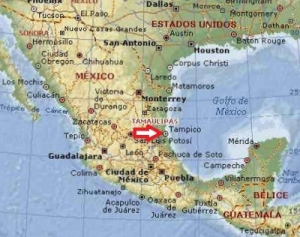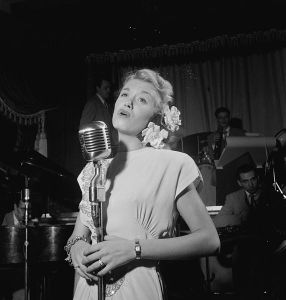
Tampico was composed in 1945 by Allan Roberts and Doris Fisher. Stan Kenton recorded the song in 1945 with June Christy doing the vocals. The song was a top-ten hit and established Christy right away as a band vocalist.
During her high school years, Christy (born Shirley Luster) sang with Bill Oetzel and his Orchestra, the Ben Bradley Band, and Bill Madden’s Band. After high school, the young Miss Luster moved to Chicago, changed her name to Sharon Leslie, and sang with a group led by bandleader, Boyd Raeburn who was starting to develop the progressive style of jazz usually associated with his name. In 1945, after hearing that Anita O’Day had left Stan Kenton’s Orchestra as his girl vocalist, she auditioned and was chosen to replace O’Day. Kenton changed her name from Sharon Leslie to June Christy, her professional name for the remainder of her career, and had her performing with the band a week later in Evansville, Indiana.
Stan Kenton featured Christy on such successful hits as Shoo Fly Pie and Apple Pan Dowdy, It’s Been A Long, Long, Time, Across The Alley From The Alamo, How High the Moon, and the million-selling Tampico, Kenton’s biggest-selling record. When the Kenton Band temporarily disbanded in 1948, Christy sang in nightclubs for a short time, and reunited with the band two years later in 1950.
The Allan Roberts/Doris Fisher song takes a satirical look at the Mexican city of its title, Tampico, Tamaulipas. Tampico is a city and port in the state of Tamaulipas, in the country of Mexico. It is located in the southeastern part of the state, directly north across the border from Veracruz. The name “Tampico” is of Huastec origin: tam-piko, meaning “place of otters” (literally “water dogs”). The city is surrounded by rivers and lagoons that were the habitat of a large population of otters. The song suggests that the city has become more Americanized than the United States itself, and that many of the souvenirs that can be bought there have been manufactured in the United States. Here are the lyrics of the Stan Kenton version of the song:
Ay, Tampico, Tampico, on the Gulf of Mexico
Tampico, Tampico, down in Mexico
You buy a beautiful shawl
A souvenir for Aunt Flo
Authentic Mexican art
Made in Idaho
Ay, Tampico, Tampico, on the Gulf of Mexico
Tampico, Tampico, down in Mexico
The senoritas, they wave, when you arrive at the dock
The native costumes they wear
Are slacks and bobby socks
Ay, Tampico, Tampico, on the Gulf of Mexico
Tampico, Tampico, down in Mexico
You buy some pottery there
To beat the luxury tax
You find that when you get home
They sell it cheaper at Saks
Ay, Tampico, Tampico, on the Gulf of Mexico
Tampico, Tampico, down in Mexico
You ask a Mexican band
To play a rumba down there
He turns and says to the boys
“Hey, fellas, dig that square!”
Ay, Tampico, Tampico, on the Gulf of Mexico
Tampico, Tampico, down in Mexico
Down in Mexico
By the way, some versions of the lyrics show the word “Mexico” spelled Mehico because that is the way the word sounds. Actually, to spell the word that way does not make too much sense as the “h” is silent in Spanish. A more correct spelling of Mexico is “Mejico” or better still, “Meaheco,” if you are going to spell it phonetically in English.
Apart from the title of a 1945 song, Tampico appears several times in popular culture: in Joseph Hergesheimer’s 1926 novel Tampico, which tells a tale of expatriates living in the city; John Huston’s opening scenes of his motion picture epic, The Treasure of the Sierra Madre are set in Tampico; Elizabeth Braun’s novel Tampico’s Gold describes Tampico in poetic detail, and Jimmy Buffett’s song Tampico Trauma tells of his experiences in the city.
Other recordings of Tampico were made by Benny Goodman, Doris Fisher, and Edmundo Ros, but only the Stan Kenton version charted on the Billboard charts. I am including the Edmundo Ros recording, since it is somewhat different than the Kenton version.
To listen to these recordings, click on the song title. To download a song, right click on the song title, then right click on Save target as
Stan Kenton and his Orchestra, vocals by June Christy and the Band Tampico
Edmundo Ros and Rumba Band Tampico


